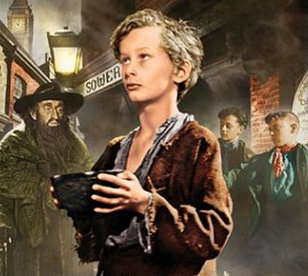
Twisting Dickens:
Analyzing David Lean's Adaptation of Oliver Twist
Home
Critical Essay
Part I
Part II
Part III
Bibliography
Related Web Links
Last Updated: 12/12/2008
Part II: Theme
Justice, humanity, and social discrimination bring about a point of similarity when comparing the personal vision of Charles Dickens to that of David Lean. While the works emphasize similar themes, the eras to which Dickens and Lean are appealing are of different mindsets. The historical timeframes in which the novel and film were released play a large part of each man’s artistic vision and hope for his audience.
Dickens was witness to the Industrial Revolution. His vision points out the flawed ways in which business was conducted. Meanwhile, the individual person was overlooked, being viewed only as a piece of the bigger, economic machine. Urban areas grew along with the birth rate causing the government to silently encourage a corrupt judicial system and a class of individuals who pillaged, plundered, and killed in an effort to survive. Dickens’s own Artful Dodger attests to this idea stating, “…and you’ve just as good a right to them as they have.” (Dickens, 151) Dickens depicts the conditions of England at the time of Oliver Twist in an effort to point out the great social flaws of his age. His young hero exemplifies innocence and Dickens makes a point of using Oliver’s innocence to show that all individuals are tasked with the responsibility to assist others. Dickens uses Oliver to show the reader how people are not meant to be parts in a machine, but how people’s lives are intricately woven together, creating the identity of one another.
Lean’s vision was focused on the war-torn people of the 1940's. Lean witnessed a time when the human rights of individuals were being denied and all civilization was involved in a world war. Post-World War II left humanity at a loss. People needed innocence and they needed a hopeful, fresh start. Lean’s vision for his film adaptation of Oliver Twist provided his audience with innocence and hope in the form of a boy who stood steadfast and refused to lose his goodness and optimism in spite of great adversity. Lean’s vision is able to take the themes of Dickens’s Oliver Twist and reinterpret them to fit the audience of his time.